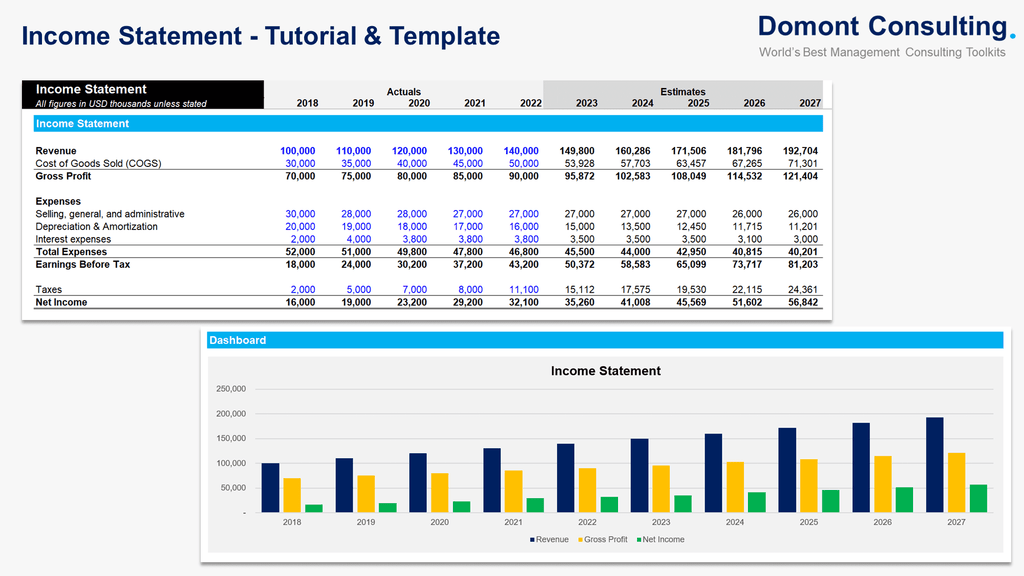Creating an Income Statement with Forecasts: A Simple Guide and Free Excel Template

Income statement definition
An income statement is a financial statement that reports a company's financial performance over a specific accounting period. It is one of the three important financial statements used for reporting a company’s financial performance, the other two being the balance sheet and the cash flow statement. The income statement focuses on the revenue, and expenses reported by a company during a particular period. It provides valuable insights into a company’s operations, the efficiency of its management, underperforming sectors, and its performance relative to industry peers.
The income statement is also known as the profit and loss (P&L) statement or the statement of revenue and expense. It starts with the details of sales and then works down to compute net income and eventually earnings per share (EPS). The income statement does not differentiate between cash and non-cash receipts (sales in cash vs. sales on credit) or cash vs. non-cash payments/disbursements (purchases in cash vs. purchases on credit).
Key income statement items
Revenue is the total amount of money a company earns from its operations, usually from the sale of goods or services. For example, a car manufacturer’s revenue would be the total amount of money it earns from selling cars.
Cost of Goods Sold (COGS) represents the direct costs associated with producing or delivering the goods or services sold by a company. In the auto industry, COGS would include the cost of raw materials, labor, and other expenses directly related to manufacturing vehicles.
Gross Profit is calculated by subtracting the COGS from the revenue.
Selling, General, and Administrative (SG&A) expenses represents the costs associated with a company's non-production activities, such as sales, marketing, and administrative functions. In the auto industry, SG&A expenses would include salaries of sales personnel, advertising expenses, rent for office spaces, and other costs related to running the business.
Depreciation & Amortization: Depreciation refers to the systematic allocation of the cost of a tangible asset over its useful life. Amortization, on the other hand, is the process of spreading out the cost of an intangible asset over its useful life. In the auto industry, depreciation and amortization expenses would include the depreciation of manufacturing equipment, vehicles, and amortization of patents or trademarks.
Interest Expenses represents the costs associated with borrowing money or using credit facilities. Interest expenses are incurred when a company has outstanding debt or loans. In the auto industry, interest expenses would include interest paid on loans used to finance manufacturing facilities or purchase equipment.
Earnings Before Tax is calculated by subtracting the SG&A expenses, Depreciation & Amortization and interest expenses from the Gross Profit
Net Income is calculated by subtracting taxes from the Earnings Before Tax
Step-by-step tutorial to create an income statement with forecasts
Step 1: Open our income statement template and adjust the periods based on your requirement cars.

Step 2: Adjust the items listed in the income statement based on your specificities.

Step 3: Input your numbers in the historical periods of your income statement. This will automatically update the historical periods of the Assumptions section.

Step 4: Input the assumptions that will be used to automatically calculate the future periods of your income statement.

Step 5: Review your numbers and automatically updated dashboard to make sure that everything is correct and makes sense.

Download our Tutorial and Template using a computer:
Need more help? Check our Toolkits:
- Corporate & Business Strategy Toolkit
- Financial Modeling, Planning & Analysis Toolkit
- Business Plan and Entrepreneurship Toolkit


